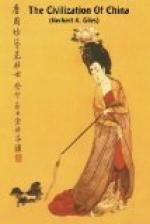The literary activities of the Chinese, and their output of literature, have always been on a colossal scale; and of course it is entirely due to the early invention of printing that, although a very large number of works have disappeared, still an enormous bulk has survived the ravages of war, rebellion and fire.
This art was rather developed than invented. There is no date, within a margin even of half a century either way, at which we can say that printing was invented. The germ is perhaps to be found in the engraving of seals, which have been used by the Chinese as far back as we can go with anything like historical certainty, and also of stone tablets from which rubbings were taken, the most important of these being the forty-six tablets on which five of the sacred books of Confucianism were engraved about A.D. 170, and of which portions still remain. However this may be, it was during the sixth century A.D. that the idea of taking impressions on paper from wooden blocks seems to have arisen, chiefly in connexion with religious pictures and tracts. It was not widely applied to the production of books in general until A.D. 932, when the Confucian Canon was so printed for the first time; from which point onwards the extension of the art moved with rapid strides.
It is very noticeable that the Chinese, who are extraordinarily averse to novelties, and can hardly be induced to consider any innovations, when once convinced of their real utility, waste no further time in securing to themselves all the advantages which may accrue. This was forcibly illustrated in regard to the introduction of the telegraph, against which the Chinese had set their faces, partly because of the disturbance of geomantic influences caused by the tall telegraph poles, and partly because they sincerely doubted that the wires could achieve the results claimed. But when it was discovered that some wily Cantonese had learnt over the telegraph the names of the three highest graduates at the Peking triennial examination, weeks before the names could be known in Canton by the usual route, and had enriched himself by buying up the tickets bearing those names in the great lotteries which are always held in connexion with this event, Chinese opposition went down like a house of cards; and the only question with many of the literati was whether, at some remote date, the Chinese had not invented telegraphy themselves.
Moveable types of baked clay were invented about A.D. 1043, and some centuries later they were made of wood and of copper or lead; but they have never gained the favour accorded to block-printing, by which most of the great literary works have been produced. The newspapers of modern days are all printed from moveable types, and also many translations of foreign books, prepared to meet the increasing demand for Western learning. The Chinese have always been a great reading people, systematic education culminating in competitive examinations for students going back to




